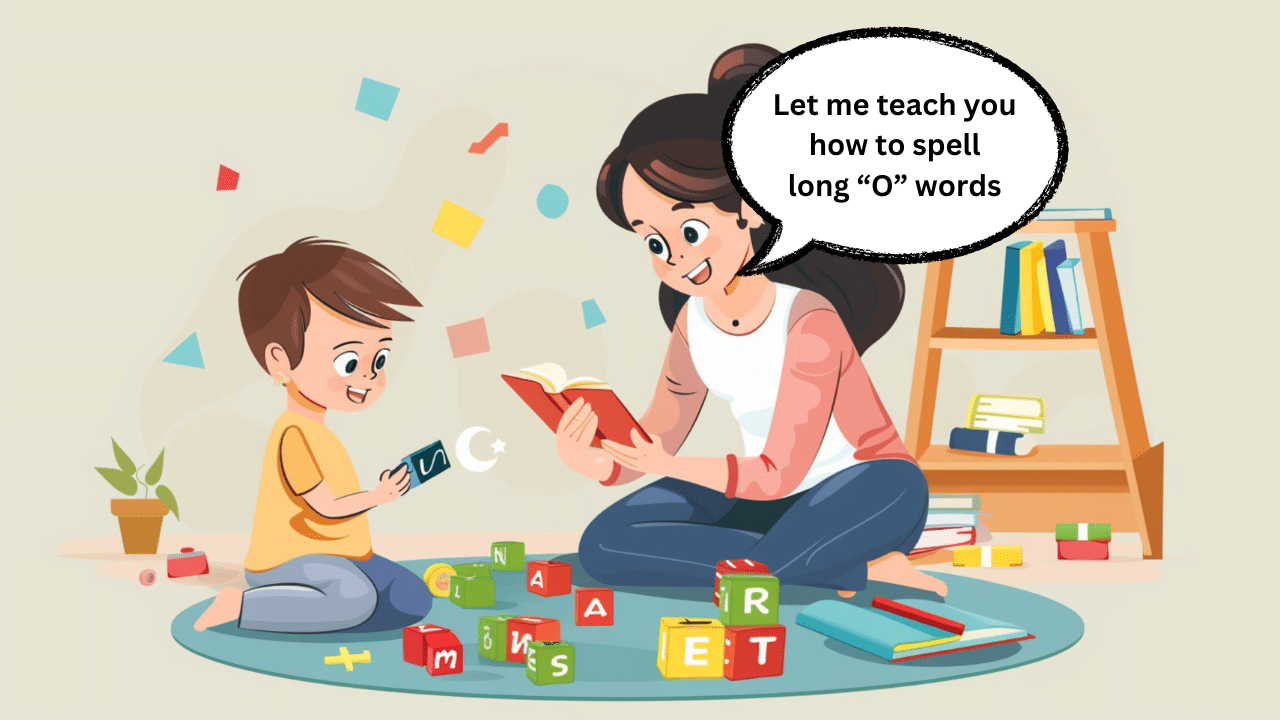Have you ever noticed how the letter “O” can make various sounds?
From the long “oh” in “snow” to the “oo” sound in “moon,” long ‘O’ words can be tricky for young readers to master.
As a parent, you may search for ways to support your child as they learn to recognize these different vowel sounds.
In this article, we’ll embark on an exciting journey into the world of long O words.
As a reading specialist with over a decade of experience, we’ll share our expertise on the four main long O sound patterns, provide numerous examples, and offer practical tips to help your child gain confidence in reading and spelling these words.
By the end of this guide, you’ll be well-equipped to assist your young reader in tackling long O words with enthusiasm and success. Let’s unlock the secrets of the long ‘O’ together!
Understanding Long ‘O’ Spellings

There are a few basic patterns to remember regarding long O spellings.
As a teacher with over a decade of experience helping students master phonics, we’ve found that understanding these patterns is key to building reading and spelling confidence.
The most common spelling for /ō/ is a single letter “O” at the end of a syllable, as in “go,” “no,” and “hero.”
We also frequently see the “O” followed by a silent “E” in words like “hope,” “nose,” and “phone.” This silent “E” indicates that the preceding vowel will make its long sound.
Another pattern to watch for is “OA,” which typically appears in the middle of words like “boat,” “coat,” and “soap.” In contrast, “OW” often comes at the end of words, as in “snow” and “grow.”
Less common spellings include “OU” (e.g., “soul,” “shoulder”) and “OUGH” (e.g., “dough,” “though”). While these patterns are trickier, they’re still worth teaching to help students tackle a wider range of words.
By familiarizing students with these long O spelling patterns and providing ample examples, we can equip them with the tools they need to become confident, capable readers and spellers.
Common Words and Exceptions
Now that we’ve covered the basic long ‘O’ spelling patterns let’s examine some common words and exceptions.
Highlighting these words helps students solidify their understanding and promotes more accurate reading and spelling.
Some frequently encountered long ‘O’ words include “go,” “so,” “home,” “open,” and “over.”
These words follow the common patterns discussed earlier, making them excellent examples for reinforcing the rules.
However, English is notorious for its exceptions, and long ‘O’ words are no exception!
Take the word “do,” for instance. Despite ending in “O,” it makes the /oo/ sound rather than /ō/.
Similarly, “to” and “two” break the mold, with “to” making the /oo/ sound and “two” representing the number 2.
Another quirky exception is the word “one.” Here, the “O” is followed by “NE,” but the word makes the /wuh/ sound instead of /ō/.
Words like “done” and “come” also deviate from the standard long O patterns.
By explicitly teaching these common words and exceptions alongside the regular spelling patterns, we can help students develop a more comprehensive understanding of long O sounds and improve their overall literary skills.
Encouraging students to create personalized word lists or engage in interactive games focusing on these words can make learning more engaging and effective.
Teaching Strategies for Long ‘O’ Sounds

Incorporating various teaching strategies is crucial for helping students master long O sounds.
Engaging multiple senses and catering to different learning styles can create a more inclusive and effective learning environment.
Different ways of incorporating and practicing can create a much more established and definitive method of teaching the long ‘O’ sounds.
Here are a few of them:
Visual Aids
- Use picture cue cards to associate words with correct spellings.
- For example, a flashcard with a boat image and the word “boat” reinforces the “OA” pattern.
- It is beneficial for visual learners and serves as a reference tool.
Word Sorting
- Categorize words based on long ‘O’ spellings (e.g., “O,” “OA,” “OW”).
- It helps students recognize and internalize spelling patterns.
- Engage students with memory games or interactive sorting exercises.
Phoneme-Grapheme Mapping
- Isolate phonograms and practice connecting sounds to written representations.
- Use sound boxes or Phonics & Spelling Through Grapheme Mapping book.
- Students break down words into individual sounds and identify corresponding spellings.
- The systematic approach is helpful for auditory learners.
Multisensory Techniques
- Simultaneous Oral Spelling (SOS): students say each letter aloud while writing the word.
- Engages both auditory and kinesthetic pathways.
- It is beneficial for hands-on learners and those who learn through verbal repetition.
Interactive Games and Activities
- Incorporate games to make learning long ‘O’ words engaging and enjoyable.
- Modify existing games by adding flashcards or create custom word work games.
- Transform mundane practice into an exciting challenge.
- Foster a positive learning environment to develop a love for language and build confidence.
By combining these teaching strategies, educators can cater to different learning styles and create a more inclusive and effective learning experience for students mastering long O sounds.
Different Spelling variations with Example

Four different common variations in the entire spelling chart are essential for you to note.
In the following segment, we have listed all four with the definitive example.
1. “o_e” Pattern and Important Words
The “o_e” pattern, also known as the “Magic E” or “Silent E” pattern, is the most common way to represent the long ‘O’ sound in single-syllable words.
In this pattern, the “o” is followed by a consonant and a silent “e” at the end of the word.
The silent “e” signals the reader that the preceding vowel should be pronounced as a long vowel sound. Some important words that follow this pattern include:
– phone
– joke
– home
– note
– globe
– stone
– close
By introducing the “o_e” pattern first, educators can build upon students’ knowledge of the “Magic E” rule, which also applies to other long vowel sounds.
2. “oa” Pattern with Examples
The “oa” pattern is another consistent representation of the long ‘O’ sound. Unlike the “o_e” pattern, “oa” appears at the beginning or middle of single-syllable words.
When students encounter the “oa” combination, they can be confident that it will make the long ‘O’ sound. Here are some examples:
– Beginning of the word: oat, oak, oar
– Middle of the word: boat, coat, goat, soap, road, toast
Encouraging students to practice reading and writing words with the “oa” pattern will help them internalize this spelling variation and improve their reading fluency.
3. “ow” Pattern: Usage and Key Words
The “ow” pattern is commonly used to represent the long O sound at the end of single or double-syllable words.
Some keywords that follow this pattern include:
– One-syllable words: low, snow, show, row, own, slow
– Two-syllable words: yellow, pillow, shadow, window, hollow
It’s important to note that when forming the irregular past tense of certain words, an “n” is added to the end of the “ow” pattern.
Examples include grown, blown, known, and thrown.
However, there are a few exceptions to the “ow” pattern, such as cow, how, and now, where “ow” makes the “ou” sound as in “out.” Make sure to point out these exceptions to help students avoid confusion.
4. The Unique “oe” Vowel Sound
The “oe” vowel team is the least common way to represent the long ‘O’ sound, but students must still recognize this pattern.
The “oe” pattern typically appears at the end of single-syllable words, such as:
– toe
– foe
– hoe
– doe
Sometimes, the “oe” pattern can be found in compound words, like tiptoe and hoecake.
One unique aspect of the “oe” pattern is that there are no significant exceptions to this spelling variation, making it a reliable option for students when they encounter it in words.
By providing a comprehensive overview of these long ‘O’ spelling variations, along with clear examples and practice opportunities, educators can help students develop a strong foundation in reading and spelling words with the long O sound.
Consistently reinforcing these patterns through various activities and exercises will improve reading fluency and confidence in tackling more complex texts.
Wrapping it Up
Mastering the various long ‘O’ spelling patterns is crucial in developing strong reading and writing skills.
By understanding the common variations, such as “o_e,” “oa,” “ow,” and “oe,” students can confidently tackle words containing the long ‘O’ sound.
Throughout this article, we’ve explored the intricacies of each spelling pattern, providing important examples and highlighting key exceptions.
From the “Magic E” rule in “o_e” words to the reliability of the “oe” vowel team, each pattern contributes to a comprehensive understanding of long ‘O’ spellings.
The ability to read and spell words with the long ‘O’ sound is a gateway to a world of knowledge and expression.
With dedication and practice, your students will gain the confidence and skills they need to become proficient readers and writers, unlocking countless academic and personal growth opportunities.
If you found this article helpful, please share it with your fellow educators and parents. Together, we can make a difference in the lives of young learners, one long ‘O’ word at a time!
